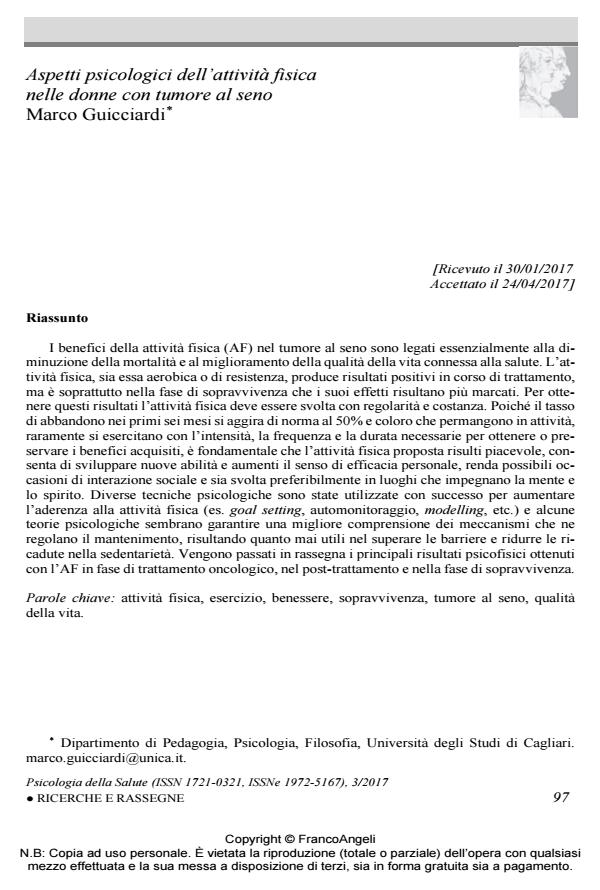Aspetti psicologici dell’attività fisica nelle donne con tumore al seno
Titolo Rivista PSICOLOGIA DELLA SALUTE
Autori/Curatori Marco Guicciardi
Anno di pubblicazione 2017 Fascicolo 2017/3
Lingua Italiano Numero pagine 18 P. 97-114 Dimensione file 294 KB
DOI 10.3280/PDS2017-003005
Il DOI è il codice a barre della proprietà intellettuale: per saperne di più
clicca qui
Qui sotto puoi vedere in anteprima la prima pagina di questo articolo.
Se questo articolo ti interessa, lo puoi acquistare (e scaricare in formato pdf) seguendo le facili indicazioni per acquistare il download credit. Acquista Download Credits per scaricare questo Articolo in formato PDF

FrancoAngeli è membro della Publishers International Linking Association, Inc (PILA)associazione indipendente e non profit per facilitare (attraverso i servizi tecnologici implementati da CrossRef.org) l’accesso degli studiosi ai contenuti digitali nelle pubblicazioni professionali e scientifiche
I benefici della attività fisica (AF) nel tumore al seno sono legati essenzialmente alla diminuzione della mortalità e al miglioramento della qualità della vita connessa alla salute. L’attività fisica, sia essa aerobica o di resistenza, produce risultati positivi in corso di trattamento, ma è soprattutto nella fase di sopravvivenza che i suoi effetti risultano più marcati. Per ottenere questi risultati l’attività fisica deve essere svolta con regolarità e costanza. Poiché il tasso di abbandono nei primi sei mesi si aggira di norma al 50% e coloro che permangono in attività, raramente si esercitano con l’intensità, la frequenza e la durata necessarie per ottenere o preservare i benefici acquisiti, è fondamentale che l’attività fisica proposta risulti piacevole, consenta di sviluppare nuove abilità e aumenti il senso di efficacia personale, renda possibili occasioni di interazione sociale e sia svolta preferibilmente in luoghi che impegnano la mente e lo spirito. Diverse tecniche psicologiche sono state utilizzate con successo per aumentare l’aderenza alla attività fisica (es. goal setting, automonitoraggio, modelling, etc.) e alcune teorie psicologiche sembrano garantire una migliore comprensione dei meccanismi che ne regolano il mantenimento, risultando quanto mai utili nel superare le barriere e ridurre le ricadute nella sedentarietà. Vengono passati in rassegna i principali risultati psicofisici ottenuti con l’AF in fase di trattamento oncologico, nel post-trattamento e nella fase di sopravvivenza.
Parole chiave:Attività fisica, esercizio, benessere, sopravvivenza, tumore al seno, qualità della vita.
- Editorial: Psychological Factors as Determinants of Medical Conditions, Volume II Andrea Caputo, Carmelo Mario Vicario, Valentina Cazzato, Gabriella Martino, in Frontiers in Psychology 865235/2022
DOI: 10.3389/fpsyg.2022.865235 - Editorial: Psychological Factors as Determinants of Medical Conditions Gabriella Martino, Viviana Langher, Valentina Cazzato, Carmelo Mario Vicario, in Frontiers in Psychology 2502/2019
DOI: 10.3389/fpsyg.2019.02502
Marco Guicciardi, Aspetti psicologici dell’attività fisica nelle donne con tumore al seno in "PSICOLOGIA DELLA SALUTE" 3/2017, pp 97-114, DOI: 10.3280/PDS2017-003005